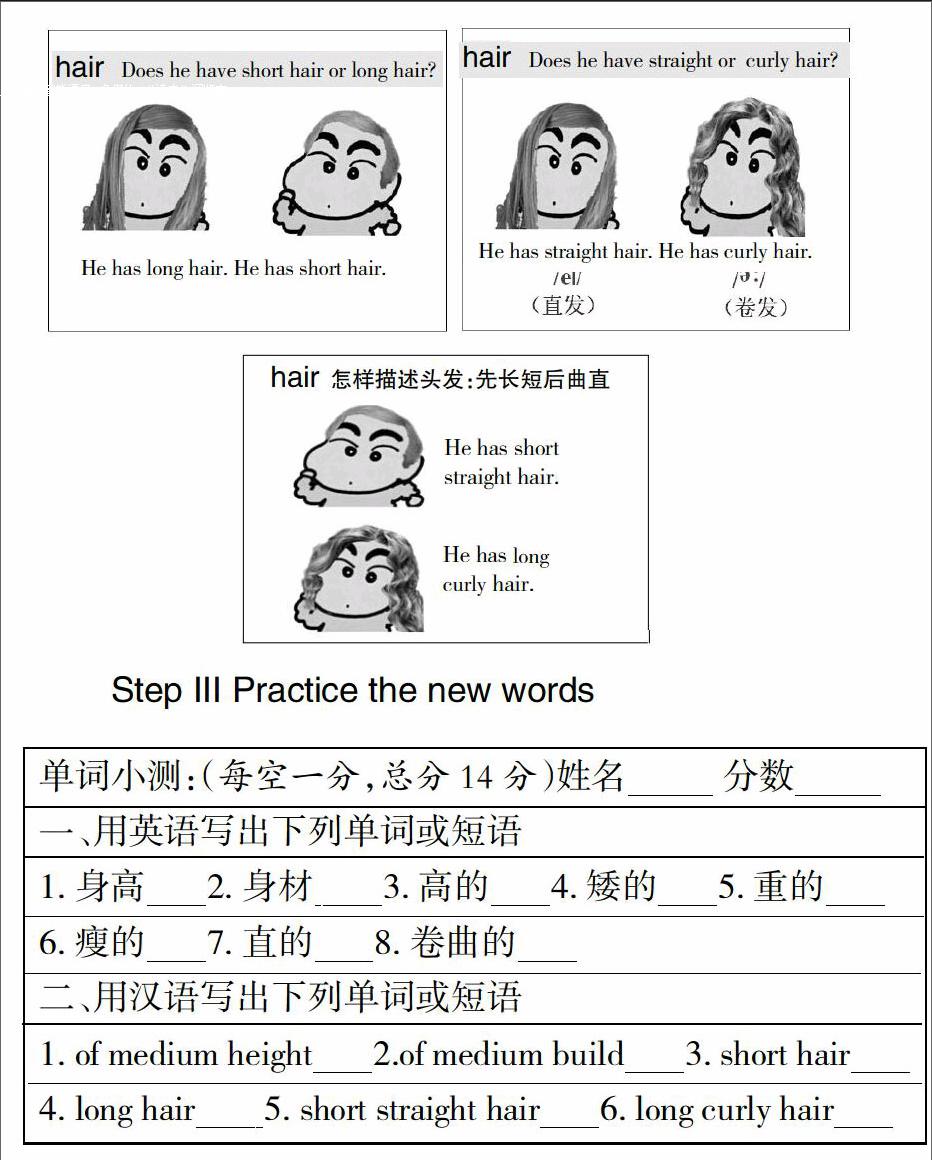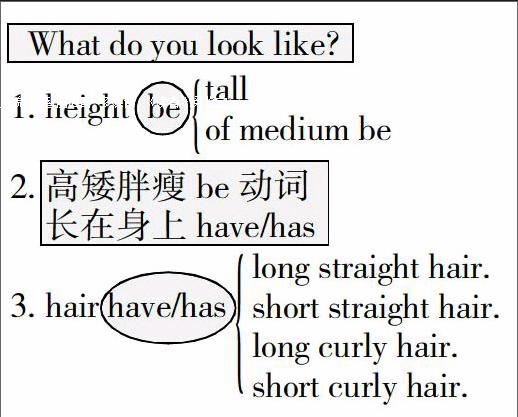Unit 9 What does he look like? Section A 1a—1c教学设计及反思
2015-08-29李丹
李丹



【本课选自人教版义务教育课程标准实验教科书《英语》(新目标)七年级下册。】
一、教材内容与分析
本部分呈现了在地铁站接朋友的场景,自然地引入了询问和简单描述人物外貌的典型句型和重点词汇,然后通过听力活动的输入和针对性的对话训练,导入整个单元的话题,让学生学会如何用简单的句型和词汇描述人物的外貌,是一节典型的听说课。
二、教学目标
1.语言知识目标:
正确描述人物的外貌,掌握描述外貌的形容词:short, tall, thin, heavy, long, curly, straight.
句型: What do you look like? Im..., and I have...What does he/she look like? He/She is... , and he/she has...
2.语言技能目标:
能够利用所学词汇及句型描述同学、朋友的外貌特征。
3.情感态度目标:
让学生学会友好客观地描述人物的外貌。
三、教学重点、难点
重点:熟练掌握描述人物形象的单词和句型。
难点:能区别be和 have/has的用法。
四、教学步骤
Step I Lead-in
T: Here is a person, she is of medium height, she is of medium build, and she has long curly hair. Who is she?
Ss: You.
(Show the picture on the screen.)
T: Yes, today well learn Unit 9 What does he look like? please read after me “What does he look like”...
(Write the title on the blackboard.)
T: How to describe peoples looks? We talk about peoples looks from three parts: height, build, and hair. Now please read after me “looks” “height”...
(Put the cards on the blackboard.)
Step II New Words
T: Is he tall or short?
Ss: He is tall. He is short.
T: Please read after me “tall”...
T: Is he tall or short?
Ss: He isnt tall or short. He is of medium height.
T: Pay attention to “of”, be of + n.
(Present the new words “heavy”“thin”“be of medium build” like this.)
T: Does he have long hair or short hair?
Ss: He has long hair.
T: 我们想说“他留着短直发”, we can say, he has short straight hair.我们想说“他留着长卷发”, we can say, he has long curly hair. Please read after me “long curly hair”... So how to describe peoples hair? We can say “先长短后曲直”, please read together.
Step III Practice the new words
T: Now put these new words into English“高的”...and then put these words into Chinese.
(Show all the pictures about new words on the screen.)
T: Now check your words according to the paper.
T: Please turn to page 49. Look at 1a. Match the words with the people in the picture. You can use some letters more than once. Now, stop. Who can give us the right answer? OK, you please.
Ss: Short hair is e...
Step IV Present the new drill
T: Now look at me. Im of medium height, Im of medium build, and I have long straight hair. So the order to describe peoples looks is “height”“build”, and “hair”. We can say:身高, 身材加发型. Please read together.endprint
Ss:身高, 身材加发型。
T: When we talk about “height”, we can say, Im tall, Im of medium height, and Im short. Now please read together.
(Present the new words “build”“hair” like this.)
T: Pay attention, when we talk about “height” and “build”, we use the verb “be”, and when we talk about “hair”, we use “have/has”. So here we can say “高矮胖瘦be动词, 长在身上have/has.” Please read together.
Step V Practice the drill
T: What do you look like?
Ss: Im short and thin. I have short curly hair.
T: Give you one minute, practice in pairs like this.
Step VI Present the new drill
T: What do you look like?
S1: Im tall and heavy. I have long straight hair.
T: What does he look like?
Ss: Hes tall and heavy. He has long straight hair.
(Ask two students to practice like this.)
Step VII Practice the drill
T: Work in pairs, ask each other “What does he/she look like?”
Step VIII Group work
Talk about the pictures in group of four. Ask each student to talk about one person.
Step IX Listening
T: Amy cant find her friend, lets help her find him/her. First look at the picture of 1a, tell me where they are, what they are doing.
Ss: They are at the subway station...
T: Now listen and fill in the blanks in the picture above. Find out who is Amys friend.
Step X Task
Task 1: Practice in pairs. Talk about the people in the picture of 1a, and find his/her friend, using the drill “What does your friend look like?”
Task 2: Make a survey, talk about your parents looks in group of four.
(The leader of each group writes all the parents looks, and then gives a report.)
Step XI Summary and Homework
T: Who can sum up what weve learned in this class?
S: ...
(Look at the words and sentences on the blackboard to sum up this lesson.)
T: In this class, weve learned how to describe peoples looks. Todays homework, describe your favorite persons looks. Thank you, goodbye!
Ss: Goodbye!
五、板书设计
六、课后反思
这是一节典型的听说课。本课的教学重点是掌握描述人物外貌的词汇和句型。难点是学生在运用功能句型描述人物外貌时,须要分清何时用is, 何时用has。
一、突破重点——单词分类,口诀记忆
在以往的单词讲解中,很多教师都是按照传统的教学方法,填鸭式地教授。学生对单词没有生动形象的理解。因此,教师在本节课的教学中采取以下几步引导学生掌握单词。
1. 图片导入,生动理解
从描述个人外貌导入到今天的词汇学习。把外貌描写分为三方面:身高、身材和头发来讲授。每一部分相关的形容词,通过图片和数字来直观展现身高、体重等。学习过程由多媒体呈现,便于学生理解和掌握。其中有口诀提示,如:描述外貌顺序: 身高身材加发型;描述头发顺序: 先长短后曲直;为了区分be动词和have/has用法,引入口诀: 身高体重be动词,长在身上have/has.
2. 单词巩固,为“说”铺垫
单词巩固即检测,分为集体巩固和个人测试。集体巩固即多媒体呈现所有关于外貌的词汇进行英译汉和汉译英。个人检测即在教师给每人发的单词单上进行测试,把听说升华到写练。
二、突破难点——句型引领,反复操练
本课难点是学生在运用功能句型描述人物外貌时,须要分清何时用is, 何时用have/has。突破这一难点由句型练习来呈现。在句型练习上,先要让学生清楚说什么,怎么说。在这个环节中,我以自身外貌为例进行描述,同时把之前描述人物外貌特征三方面的相关词汇、句型进行媒体呈现,让学生在练习对话时有参考,能模仿。在练习描述其他人的外貌特征时,教师询问一名学生的外貌,同时让全班学生复述这名学生的长相。自然地由第一人称描述转换到第三人称描述。再由两人一组进行对话练习。另外,在句型巩固上,提供一组生活中的明星照片,学生通过描述他们的外貌特征,进一步巩固第三人称单数描述外貌的句型,为接下来的1c对话做铺垫。
在难点提升上,通过Task 2让学生设计小组调查报告,以小组合作的形式,完成对该组其他成员家人外貌的描述,同时以报告的形式呈现给全班学生。这样就把该堂课所学的词汇、句型又进行了巩固和加强。
总而言之,听说课以听说为主,并有写的巩固与提升。只有基于对教材的全面、透彻的理解,教师才能循序渐进地引导学生进行知识的输入,由实例呈现,实现知识的内化;以说为主,完成学生的输出任务。教师要给予必要的指导和方法引导,从而达到提升学生听说技能的目标。endprint
